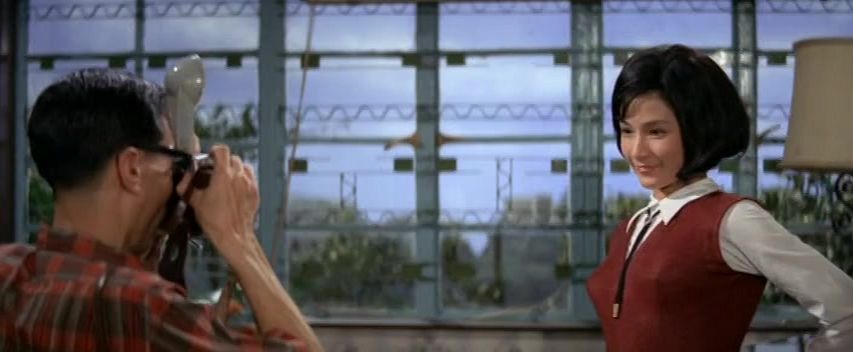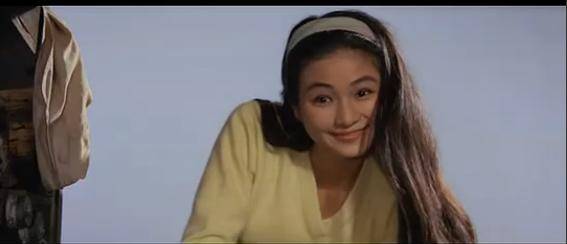Zelena
Member: Rank 2
I always considered "Shaw Brothers" synonymous with Kung-Fu movies, and didn't investigate any further, because I had zero interest in that. I don't even remember how I stumbled on this -- and it was only a few days ago -- but I found out that the Hong Kong-based Shaw Brothers studio produced hundreds of non-kung fu movies in the 1960s. These were general interest mainstream movies; dramas, comedies, and musicals, etc.
Right from the very first frame I knew I was going to enjoy The Song of Orchid Island (1965). The first shot is an early 1960s airliner landing at Kai-Tak Airport, in sharp, wide, bold, gorgeous Technicolor. I watched this whole film in Chinese without subtitles, although I understand very little Chinese. That might become my new form of amusement. It makes the whole experience that much more foreign and compelling.
This film was a bit like an anthropological journey, on two levels. For one, it takes place on a gorgeous green island off of Taiwan, inhabited by the native people. Second, it's a journey into mid-century modernizing Asia (as are the following films). National Geographic, the jet-set, traditional China, and Hollywood all colliding.
The standout feature of this movie is the impossibly beautiful 18 year old Pei Pei Cheng, skipping around the beach barefoot and generally sucking all the oxygen out of the whole universe, as she yanks on the church-bell rope with her exposed midriff. I don't think I missed much in the plot; a handsome young doctor from civilization comes to the island, is gently seduced by native girl, various obstacles, yadda yadda yadda. But the greens of the hills, the blues of the sky, and the vast foreignness of this film sucked me in, and opened up a whole new movie universe that has restored my flagging interest in Asian film. I could go on and on about this one.
The Purple Shell (1967) is an adultery drama that also opens with some amazing photography. I think this must be the influence or indeed instruction of producer Run Run Shaw, because it's common to these films with different directors. The beach scenes, the outdoor, the stunning light pouring into exquisite modernist apartments, and shots of people sipping cocktails on rose-garden terraces overlooking the mountains and the sea, etc. Great stuff.
Here we have a real cultural time-capsule, with some standout lines on how society deals with adulterers. As the story unfolds, the two lovers never consummate their romance, even though they have been found out and are not getting laid within their respective marriages. I was like, erm, really? It turns out, this was written by Queen of Chinese tv drama, writer Yao Chiung when she was a young girl. Probably when she was a young, nerdy, book-writing virgin who didn't quite understand how sex works. That's what made this one a 'fantasy' film, as far as I'm concerned, but a good one. It's a great script.
Blue Skies (1968) is a more conventional, tent-pole musical melodramedy. It seems like almost half the film are scenes of the musical theater troupe performing a number on stage, which is economical, I guess. Some bizarre and totally enjoyable skits including the 'big-headed kids' and the sexy cat-suit one, the Gidget beach-party scene, and others. All the groovy mid-60s dancing and trying to be cool was what made this one a comedy, and a really enjoyable one. There's one great scene of an uncle teaching his little niece to do the twist, which really encapsulates the fun for the whole family thing about these movies. But again, Pei Pei Cheng pretty much inhales the whole scene, and I am watching her body of work one by one just to ravish her with my eyes. This was the korean television of its day. @plsletitrain might like this one -- or might not.
Lover's Rock (1964) was Pei Pei Cheng's debut, and what a debut! This one sprawls a little more and has a more complex and coherent plot, although still light and thin with a lot of holes and it's necessary to give these movies some slack about that. It's important to stress that we're judging these movies by a different standard. You see many of the physical artifacts of mid-century middle class life; the transistor radios, the cars, the stunning dresses, etc, but this was Hong Kong and Taiwan in the 60s. Almost everybody was a refugee from the mainland, one generation out of extreme poverty and war. On a cultural level, these films are simple, and yet extraordinary production value. The Shaw Bros must have been making a lot of money, because they spared little expense on the Technicolor and the cameras, considering these were films by, for, and about developing societies.
Lover's Rock takes place in a fishing village on Taiwan's east coast, where the town beauty has just returned from graduating high school in the big town. A young lad meets her on the bus and follows her into town like a puppy dog and settles there, taken under the wing of a gruff and grouchy fisherman, with whom he forms an unlikely friendship. Along the way he grows up a little.
There's a real primitive element of everyone in the village is a family, much like Indian movies, but somehow much less suffocating, partly because teenage Pei Pei is such a pouty, foot-stomping rebellious brat in all these films. Wei Ou, who plays the evil husband from hell in the Purple Shell and died before the age of 40, is the dock-ruffian villain here. Great character actor.
The first time I posted on the imdb forum about Asian film, it was about the mid-century color Japanese films, and the general scarcity of them. Now I have found something I have been looking for for a long time; just some documentation of the look of 1960s Hong Kong and Taiwan (although the city is not shown much in these films -- they are trying to transport audiences to another world, after all) and all the physical artifacts of that time, in high-quality photography. With the current trend of actors in Asia slathering on the make-up and moisturizer to become more white, I found it refreshing to see all these beautiful tanned and tawny south China actresses (and actors).
In all these years, I haven't seen any of these titles reviewed by others on the forums -- although I'm sure ebossert has seen some. Unfortunately, most of them are difficult or impossible to find, because the whole set was bought by a single dist company. I would just eat these up in blu-ray, but probably most will never be converted in high-def. Still the ones that are available are a real treasure of experience.
These are all in the low to high 8s for me, and I plan to watch as many more as I can find. I'm even watching Auntie Lan in Chinese because the photography is so gorgeous.


Right from the very first frame I knew I was going to enjoy The Song of Orchid Island (1965). The first shot is an early 1960s airliner landing at Kai-Tak Airport, in sharp, wide, bold, gorgeous Technicolor. I watched this whole film in Chinese without subtitles, although I understand very little Chinese. That might become my new form of amusement. It makes the whole experience that much more foreign and compelling.
This film was a bit like an anthropological journey, on two levels. For one, it takes place on a gorgeous green island off of Taiwan, inhabited by the native people. Second, it's a journey into mid-century modernizing Asia (as are the following films). National Geographic, the jet-set, traditional China, and Hollywood all colliding.
The standout feature of this movie is the impossibly beautiful 18 year old Pei Pei Cheng, skipping around the beach barefoot and generally sucking all the oxygen out of the whole universe, as she yanks on the church-bell rope with her exposed midriff. I don't think I missed much in the plot; a handsome young doctor from civilization comes to the island, is gently seduced by native girl, various obstacles, yadda yadda yadda. But the greens of the hills, the blues of the sky, and the vast foreignness of this film sucked me in, and opened up a whole new movie universe that has restored my flagging interest in Asian film. I could go on and on about this one.
The Purple Shell (1967) is an adultery drama that also opens with some amazing photography. I think this must be the influence or indeed instruction of producer Run Run Shaw, because it's common to these films with different directors. The beach scenes, the outdoor, the stunning light pouring into exquisite modernist apartments, and shots of people sipping cocktails on rose-garden terraces overlooking the mountains and the sea, etc. Great stuff.
Here we have a real cultural time-capsule, with some standout lines on how society deals with adulterers. As the story unfolds, the two lovers never consummate their romance, even though they have been found out and are not getting laid within their respective marriages. I was like, erm, really? It turns out, this was written by Queen of Chinese tv drama, writer Yao Chiung when she was a young girl. Probably when she was a young, nerdy, book-writing virgin who didn't quite understand how sex works. That's what made this one a 'fantasy' film, as far as I'm concerned, but a good one. It's a great script.
Blue Skies (1968) is a more conventional, tent-pole musical melodramedy. It seems like almost half the film are scenes of the musical theater troupe performing a number on stage, which is economical, I guess. Some bizarre and totally enjoyable skits including the 'big-headed kids' and the sexy cat-suit one, the Gidget beach-party scene, and others. All the groovy mid-60s dancing and trying to be cool was what made this one a comedy, and a really enjoyable one. There's one great scene of an uncle teaching his little niece to do the twist, which really encapsulates the fun for the whole family thing about these movies. But again, Pei Pei Cheng pretty much inhales the whole scene, and I am watching her body of work one by one just to ravish her with my eyes. This was the korean television of its day. @plsletitrain might like this one -- or might not.
Lover's Rock (1964) was Pei Pei Cheng's debut, and what a debut! This one sprawls a little more and has a more complex and coherent plot, although still light and thin with a lot of holes and it's necessary to give these movies some slack about that. It's important to stress that we're judging these movies by a different standard. You see many of the physical artifacts of mid-century middle class life; the transistor radios, the cars, the stunning dresses, etc, but this was Hong Kong and Taiwan in the 60s. Almost everybody was a refugee from the mainland, one generation out of extreme poverty and war. On a cultural level, these films are simple, and yet extraordinary production value. The Shaw Bros must have been making a lot of money, because they spared little expense on the Technicolor and the cameras, considering these were films by, for, and about developing societies.
Lover's Rock takes place in a fishing village on Taiwan's east coast, where the town beauty has just returned from graduating high school in the big town. A young lad meets her on the bus and follows her into town like a puppy dog and settles there, taken under the wing of a gruff and grouchy fisherman, with whom he forms an unlikely friendship. Along the way he grows up a little.
There's a real primitive element of everyone in the village is a family, much like Indian movies, but somehow much less suffocating, partly because teenage Pei Pei is such a pouty, foot-stomping rebellious brat in all these films. Wei Ou, who plays the evil husband from hell in the Purple Shell and died before the age of 40, is the dock-ruffian villain here. Great character actor.
The first time I posted on the imdb forum about Asian film, it was about the mid-century color Japanese films, and the general scarcity of them. Now I have found something I have been looking for for a long time; just some documentation of the look of 1960s Hong Kong and Taiwan (although the city is not shown much in these films -- they are trying to transport audiences to another world, after all) and all the physical artifacts of that time, in high-quality photography. With the current trend of actors in Asia slathering on the make-up and moisturizer to become more white, I found it refreshing to see all these beautiful tanned and tawny south China actresses (and actors).
In all these years, I haven't seen any of these titles reviewed by others on the forums -- although I'm sure ebossert has seen some. Unfortunately, most of them are difficult or impossible to find, because the whole set was bought by a single dist company. I would just eat these up in blu-ray, but probably most will never be converted in high-def. Still the ones that are available are a real treasure of experience.
These are all in the low to high 8s for me, and I plan to watch as many more as I can find. I'm even watching Auntie Lan in Chinese because the photography is so gorgeous.


Last edited:
